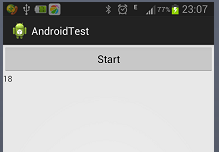理解线程
post by:追风剑情 2015-8-3 23:06
以下为一个计数器示例,通过这个示例来理解线程。
视图
<LinearLayout xmlns:android="http://schemas.android.com/apk/res/android"
xmlns:tools="http://schemas.android.com/tools"
android:layout_width="fill_parent"
android:layout_height="fill_parent"
android:orientation="vertical"
tools:context="${relativePackage}.${activityClass}" >
<Button
android:id="@+id/btnStartCounter"
android:layout_width="match_parent"
android:layout_height="wrap_content"
android:text="Start"
android:onClick="startCounter5" />
<TextView
android:id="@+id/textView1"
android:layout_width="match_parent"
android:layout_height="wrap_content"
android:text="TextView" />
</LinearLayout>
活动
package com.example.androidtest;
import android.app.Activity;
import android.os.AsyncTask;
import android.os.Bundle;
import android.os.Handler;
import android.os.Message;
import android.util.Log;
import android.view.Menu;
import android.view.MenuItem;
import android.view.View;
import android.widget.TextView;
public class ThreadingActivity extends Activity {
static TextView txtView1;
DoCountingTask task;
@Override
protected void onCreate(Bundle savedInstanceState) {
super.onCreate(savedInstanceState);
setContentView(R.layout.activity_threading);
txtView1 = (TextView) findViewById(R.id.textView1);
}
@Override
protected void onPause(){
super.onPause();
stopCounter(txtView1);
}
/**
* 方案一
* 此方案会使UI无响应。
* @param view
*/
public void startCounter1(View view){
for(int i=0; i<=1000; i++){
txtView1.setText(String.valueOf(i));
try {
Thread.sleep(1000);//UI线程中执行
} catch (InterruptedException e) {
Log.d("AndroidTest", e.getLocalizedMessage());
}
}
}
/**
* 方案二
* 此方案会使程序崩溃。
* @param view
*/
public void startCounter2(View view){
new Thread(new Runnable(){
@Override
public void run() {//工作者线程
for(int i=0; i<=1000; i++){
//在工作者线程中更新UI,会导致程序崩溃。
txtView1.setText(String.valueOf(i));//这句会使程序崩溃
try {
Thread.sleep(1000);
} catch (InterruptedException e) {
Log.d("AndroidTest", e.getLocalizedMessage());
}
}
}
}).start();
}
/**
* 方案三
* 此方案可行,但是代码十分复杂,不易维护。
* @param view
*/
public void startCounter3(View view){
new Thread(new Runnable(){
@Override
public void run() {//工作者线程
for(int i=0; i<=1000; i++){
final int valueOfi = i;
txtView1.post(new Runnable(){//UI线程
public void run(){
txtView1.setText(String.valueOf(valueOfi));
}
});
//---插入一个延迟
try {
Thread.sleep(1000);
} catch (InterruptedException e) {
Log.d("AndroidTest", e.getLocalizedMessage());
}
}
}
}).start();
}
/**
* 方案四
* 此方案可行。利用Handler类。
* @param view
*/
public void startCounter4(View view){
new Thread(new Runnable(){
@Override
public void run() {//工作者线程
for(int i=0; i<=1000; i++){
ThreadingActivity.UIupdater.obtainMessage(0, String.valueOf(i).getBytes()).sendToTarget();
try {
Thread.sleep(1000);
} catch (InterruptedException e) {
Log.d("AndroidTest", e.getLocalizedMessage());
}
}
}
}).start();
}
/**
* 方案五
* 此为推荐方案。
* @param view
*/
public void startCounter5(View view){
task = (DoCountingTask) new DoCountingTask().execute();
}
/**
* 取消任务
* 如果不调用任务的cancel()方法,就算活动销毁了(比如用户按了black键),任务还是会继续执行。
* @param view
*/
public void stopCounter(View view){
if(null != task)
task.cancel(true);
}
static Handler UIupdater = new Handler(){
@Override
public void handleMessage(Message msg){
byte[] buffer = (byte[]) msg.obj;
String strReceived = new String(buffer);
txtView1.setText(strReceived);
Log.d("AndroidTest", "running");
}
};
private class DoCountingTask extends AsyncTask<Void, Integer, Void> {
@Override
protected Void doInBackground(Void... params) {
for(int i=0; i<=1000; i++){
publishProgress(i);
try {
Thread.sleep(1000);
} catch (InterruptedException e) {
Log.d("AndroidTest", e.getLocalizedMessage());
}
//检查任务是否该终止
if(isCancelled()) break;
}
return null;
}
protected void onProgressUpdate(Integer... progress){
txtView1.setText(progress[0].toString());
Log.d("AndroidTest", "updating...");
}
}
}
运行效果
评论:
发表评论:
